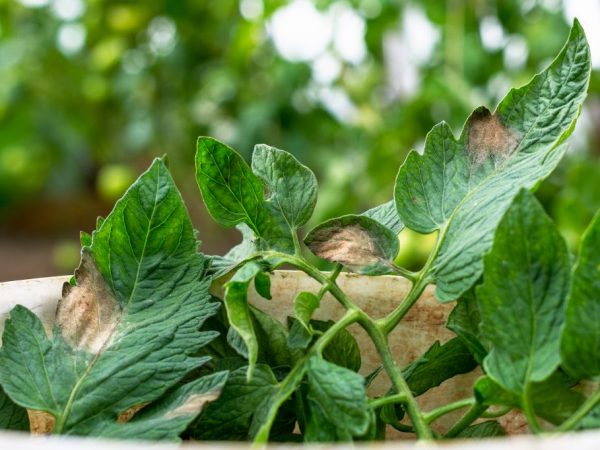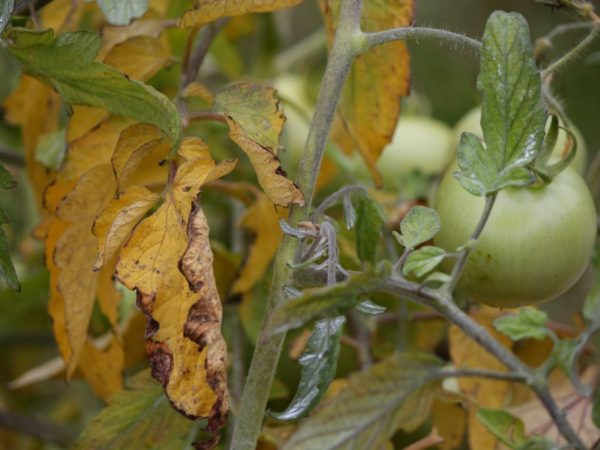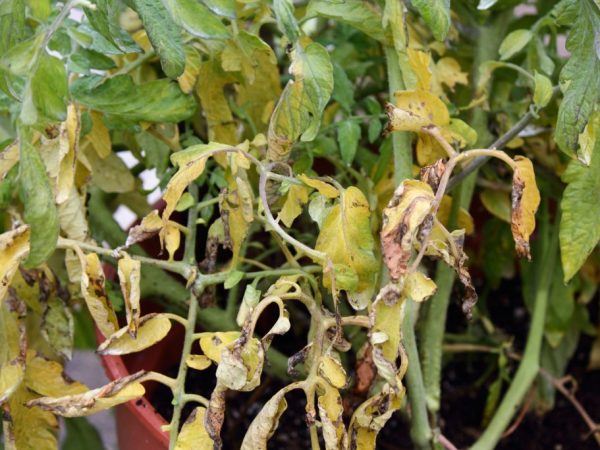Causes of yellowing tomato leaves
Any changes in the condition of the plants can be a sign of some kind of disease. Why do tomato leaves turn yellow and how to deal with it? Consider in detail the reasons and methods of treatment.

Causes of yellowing tomato leaves
Natural processes
Slight lightening of greens is a normal change that is inherent in tomatoes. Often this happens after planting seedlings in a permanent place. The procedure is stressful for the seedlings, therefore, in order to preserve the nutrition of the top, the culture has to shed the leaves.
If the lower leaves of the tomato turn yellow, then you should take a closer look at the bushes. Natural processes are almost painless for plants, there is no noticeable mass lightening and shedding of greenery. The culture itself copes by shedding the leaves.
Temperature changes
If the leaves turn yellow on ground tomatoes, this could be a sign that the vegetables are frozen. Tomatoes are very sensitive to the warmth of the earth, therefore, in cold weather, they immediately change the color of the foliage.
Heat is another culprit for the yellowness of the plates. Unhardened, weak seedlings are especially affected in the first weeks after planting in a permanent place of development. At first, the greens wither from the heat, then irreversible processes of dying off begin.
What to do when tomato leaves turn yellow? If temperature changes are the cause of the problem, we advise you to protect the seedlings. During the frost period, the planting is covered overnight with a film. In the summer heat, we recommend shading the bushes with an old cloth.
Humidity
Tomatoes are a very moisture-demanding crop. The main root of the plant reaches a length of 1.5 meters, but the main part of the system is located in the lower layers of the soil. With a lack of watering, the greens lose their turgor, brightens and curls.
Excess irrigation leads to the fact that the earth does not have time to dry out and rotting begins. This is true during cool periods with a lack of sunny days. It is especially necessary to monitor the degree of humidity in greenhouses and hotbeds. Raising the safe level causes the lower leaves of the tomatoes to turn yellow.
What needs to be done to prevent mistakes in agricultural technology? We recommend revising the irrigation schedule and drawing up a rough plan. Before each procedure, check with a stick how dry the soil is. In addition, it is necessary to regularly loosen the plantings and remove weeds. "Saddened" bushes are sprayed with a solution of "Epin" or "Zircon".
Illumination
If yellowing appears on the tomatoes, then the plants may not have enough sun. Most often, these bushes have weak foliage on the opposite side and an elongated stem. Balcony varieties and seedlings suffer from a lack of ultraviolet radiation.
To remedy the situation, it is necessary to provide the vegetables with the correct lighting. After the seeds have hatched, it is better to illuminate the seedlings with a phytolamp.If the culture has yellow leaves, then it should be rearranged to a more suitable window sill. We advise you to choose indoor hybrids that are resistant to light deficiency.
Root problems

Root health affects plant growth
Roots are the most vulnerable place in all plants. Parasitic insects devour the roots of both young and old crops. A damaged system cannot properly deliver nutrients to the tops, which causes yellowing.
Overgrown seedlings also do not have normally formed roots. Due to the fact that the plant had to develop for a long time in a confined space, the roots do not adapt well. In a new place, seedlings have to adapt to new conditions and remove excess greens.
By the way, after carelessly replanting bushes on the garden bed, roughly loosening the soil or pulling out weeds, the roots may also be damaged. After a pick, young plants get sick, which manifests itself in the form of a color change. If you find that the leaves of tomatoes turn yellow due to underground parts, then you need to wait until the system is fully restored. We recommend to water problem plantings with "Kornevin" or spray with "Epin" solution.
Top dressing
Tomatoes are a very voracious crop that prefers to develop and pamper with fruits on "fat" soils, with regular fertilization. A deficiency or excess of any of the trace elements causes a change in the color of the tops. In a neglected state, the ovaries fall off, and the harvest does not ripen well.
Nitrogen
Why do the leaves of the tomato on the site turn yellow? With a deficiency of this substance, the plant will be plain and pale. If you notice that the plates have begun to lighten and become covered with reddish veins, then this may be starvation. Lack of nitrogen is dangerous during periods of growing green mass and fruit setting. Such a crop grows small, hard and poorly stored, and the cotyledon nodes die off from the seed.
With an excess of an important nutrient, tomatoes “fatten”, increasing the tops to the detriment of products. Ripening slows down, and yellow and brown necrosis appear on the greens, which then die off. The leaves are curled, and the stem is strongly branched.
How to fix the arisen problems of agricultural technology? In case of nitrogen deficiency, we advise you to immediately irrigate with urea (one spoonful per bucket of water). An excess of a trace element is "treated" only by strong washing of the soil with thorough drying.
Potassium
The substance is necessary so that the processes of development of stems and fruits are normally regulated, and the cells begin to renew themselves correctly. With a shortage, the ripening of the crop worsens, and the leaves turn yellow unevenly from the edge, then turning into a brown border. Gradually, the yellowness spreads from the tips to the center, after which the plate is wrapped.
What to do to prevent potassium deficiency? Plants must be treated with potassium sulfate before the start of the fruiting period. Both root watering and leaf spraying are suitable. The procedure is carried out carefully, trying to get the spray gun onto the plates from above and below.
Magnesium and zinc
Both trace elements are responsible for the photosynthesis of crops and the formation of chlorophyll. If you do not fertilize the vegetables, then small yellow spots appear on the plates, leading to the necrosis of the greens. Even in tomatoes, foliage curling inward and "rusty" edges are observed. The fruits of such bushes are small and ripen ahead of schedule.
When applying dressings, we advise you to pay attention to the composition of the preparation. A comprehensive tool always contains all the necessary elements. The procedures are carried out every two weeks, alternating root and foliar activities.
Boron, sulfur and calcium

Plants can be saved
With a lack of substances, the upper parts of the bushes are most often affected. The leaves turn yellow, the tops die off. Farmers notice that "hungry" plants have begun to bush, shedding all flowers and ovaries.Leaf necrosis occurs in the most neglected state.
What to do if you notice signs of deficiency? Calcium and boron are not as important as nitrogen, potassium, or phosphorus, but in impoverished soils, there is often a shortage. It is better to replenish the substances by introducing complex preparations marked "For tomatoes". Recommended procedures are performed every two weeks, especially during the flowering period.
Diseases
The yellowing of the leaves of your tomatoes can intensify some kind of disease. Care errors after transplantation often cause the appearance of unpleasant ailments that cause discoloration of the plates. Knowing the signs of ailments, you can quickly begin treatment.
Curliness
The extermination of parasitic insects and varietal grasses is not a cosmetic procedure, but an important process for vegetables. The disease is transmitted to tomatoes through whitefly bites and from affected plant neighbors. Outbreaks are noted both in unkempt areas and adjacent vegetable gardens.
The yellow curl virus is a very dangerous disease that affects all parts of the culture. A diseased bush does not set fruit, which negatively affects the future harvest. The disease is recognized by its characteristic features:
- leaves turned yellow;
- deformation of greenery, especially the tops;
- wrinkled surface;
- noticeable veins;
- shedding flowers.
What is the best way to get rid of the disease after the leaf has turned yellow? Affected plants do not respond to treatment, so the plantings have to be removed. It is easier to prevent an illness than to deal with the consequences of carelessness later.
For the purpose of prevention, it is imperative to process seedlings from whiteflies. Regular spraying with mineral oil reduces the risk of spreading the disease. Additionally, we recommend purchasing the seeds of hybrids with immunity to ailments.
Fusarium
If the leaves of a tomato turn yellow, then this may be a sign of a dangerous fungal disease. In addition to the color change, a whitish mycelium appears on the underside. The turgor of the plates decreases and the upper parts are deformed, especially the growth point. The greens curl up, dies off, after which the affected bush dies.
Many novice agrarians do not know why fusarium occurs. Most often, the fungus is activated by crowded plantings and excessive use of mineral fertilizers. Insufficient lighting and increased humidity can also provoke ailment. The disease spreads very quickly, especially at temperatures from 27 C.
"The sources of the spread of the disease can be not only infected seeds, but also the remains of plants from compost or tools that are used to constantly cultivate the soil."
If you notice that the lower leaves of the tomato are turning yellow, then you should carefully examine each bush. The larger the damage, the less chances of saving the seedlings. A diseased tomato is a source of infection, so it is uprooted and burned behind the site. In case of minor infestation, we recommend spraying the plants with a solution of Falcon (1 mg per 3.5 l).
For prevention purposes, experienced farmers do not forget to thoroughly destroy weeds and disinfect the soil before planting seedlings. In addition, the seed is selected with immunity to fusarium and is treated with fungicides before sowing. If plants on the site often suffer from the effects of the "yellow" fungus, then we recommend moving the crop to another part of the garden.
Tomato is a very tenacious type of vegetable, but ignorance of its requirements often leads to mistakes in agricultural technology and can ruin the entire crop. If you pay attention to changes in color and structure, then you can predict the problem early on. Thanks to our review, it is now easy to understand why tomato leaves turn yellow.


